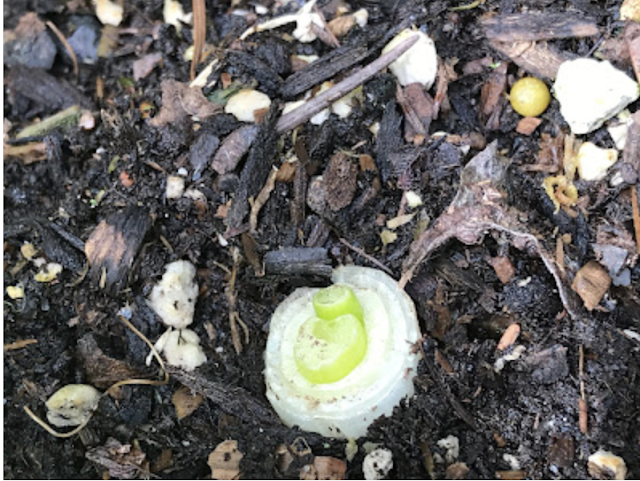Although I buy seeds for most of my vegetable gardening, here are two foods that I'm growing for free this year. This is truly free food. I use parts of foods that I've purchased in spring that are deemed waste, such as inedible seeds or root ends. I plant these bits into ordinary garden or yard soil mixed with home-made compost.
Green Onions
As I've been using grocery store green onions this spring, I've cut off about 1 inch of the root end and popped that part into some soil in a planter just outside the kitchen door. I didn't do anything special with the onion ends, just made sure the roots were intact and there was enough of the onion part (about 1 inch) to regrow. I can now see they are beginning to push up some new green growth from the root ends. I hope to have green onions for cutting in about a month.
Some folks prefer to start their green onion ends in water. I've had success planting directly into soil, provided it's kept watered (not a problem in our rainy spring weather) and likelihood of frost has passed.
What I like about growing green onions from the root end of purchased onions is that I would have otherwise just composted that root end. So I'm using a part that is basically a waste product from the green onions. In addition, you can begin harvesting from these green onions that were grown from roots in about 6 weeks after planting. Which means, I can be planting onion roots way up until early August and still have time to harvest some green tops before our weather changes in fall.
Bell Peppers
I have 6 pots of bell peppers (2 plants per pot) that I started from the seeds from a grocery store red bell pepper. As many of my neighbors do, I'm growing these plants in black pots in a very sunny spot of our yard. The seeds were free. We had the pots already. And the soil is a mixture of the soil from our yard and home-made compost. My experience with growing peppers from saved seeds from grocery store red peppers has been fair in the past. At the lesser end of harvest, I've gotten 1 or 2 small green peppers per plant. At the greater end, I've harvested 2 medium green to red peppers per plant. In all cases, the plants have been free, and I've grown them in soil from our yard/garden. If I get just one pepper from each plant, that will still be 12 free peppers for our meals or adding to homemade pickle relish.
What I like about growing peppers from the seeds collected from store-bought red peppers is this is totally free. I don't use the pepper seeds for any cooking purpose. I would otherwise add the seeds to the compost. And since it's a totally free endeavor, I'm willing to take a chance on the plants not producing as well as if I'd purchased seeds that were designed for my area. Because this is what I'd call risky gardening, I am unwilling to use purchased soil for these pots. But I will give them several drinks of my free compost tea this summer. Keeping my fingers crossed that this is one of the better years for my peppers.



It so satisfying when you can take something that was not usable for the original purpose and make something new out of it. We only occasionally grow peppers since I am only luke warm on them and my husband doesn't like them at all. I also find that peppers are a vegetable that people seem to have an abundance of in the summer (along with zucchini) and are happy to share.
ReplyDeleteHi Live and Learn,
DeleteI wholeheartedly agree -- love using every last bit of a thing!
Peppers and zucchini are harder for us to grow in my little area. The weather warms up late here, and we have so much shade from the super tall evergreens. But we enjoy what we can grow. I'm glad you can get both zucchini and peppers from others' gardens. That simplifies what you need to grow in your own.
We have many volunteer garden plants growing at this time, green onions as you mentioned, currant tomatoes, malabar spinach, and amaranth (een choi). Since my husband has osteoporosis, we rely on the spinach for his daily greens in between store seed plantings. Not only are the seeds free, but it's turning out to be a reliable source of dietary calcium. The spinach is so prolific, after a big rain the fallen seeds sprout and I almost feel guilty plucking them out. Since using insect netting and coconut coir, gardening has become less labor intensive and we can spend our time sitting with refreshments in the garden patio.
ReplyDeleteHave a wonderful day,
Laura
Hi Laura,
DeleteIt sounds like your garden has become a blessing in your and your husband's lives in more ways than one. I'm so glad that the netting and coir makes gardening easier. And how wonderful that the food that your husband needs is volunteering for you! Your garden patio sounds like an oasis, as my imagination likes to picture it.
Enjoy the rest of your day, Laura!